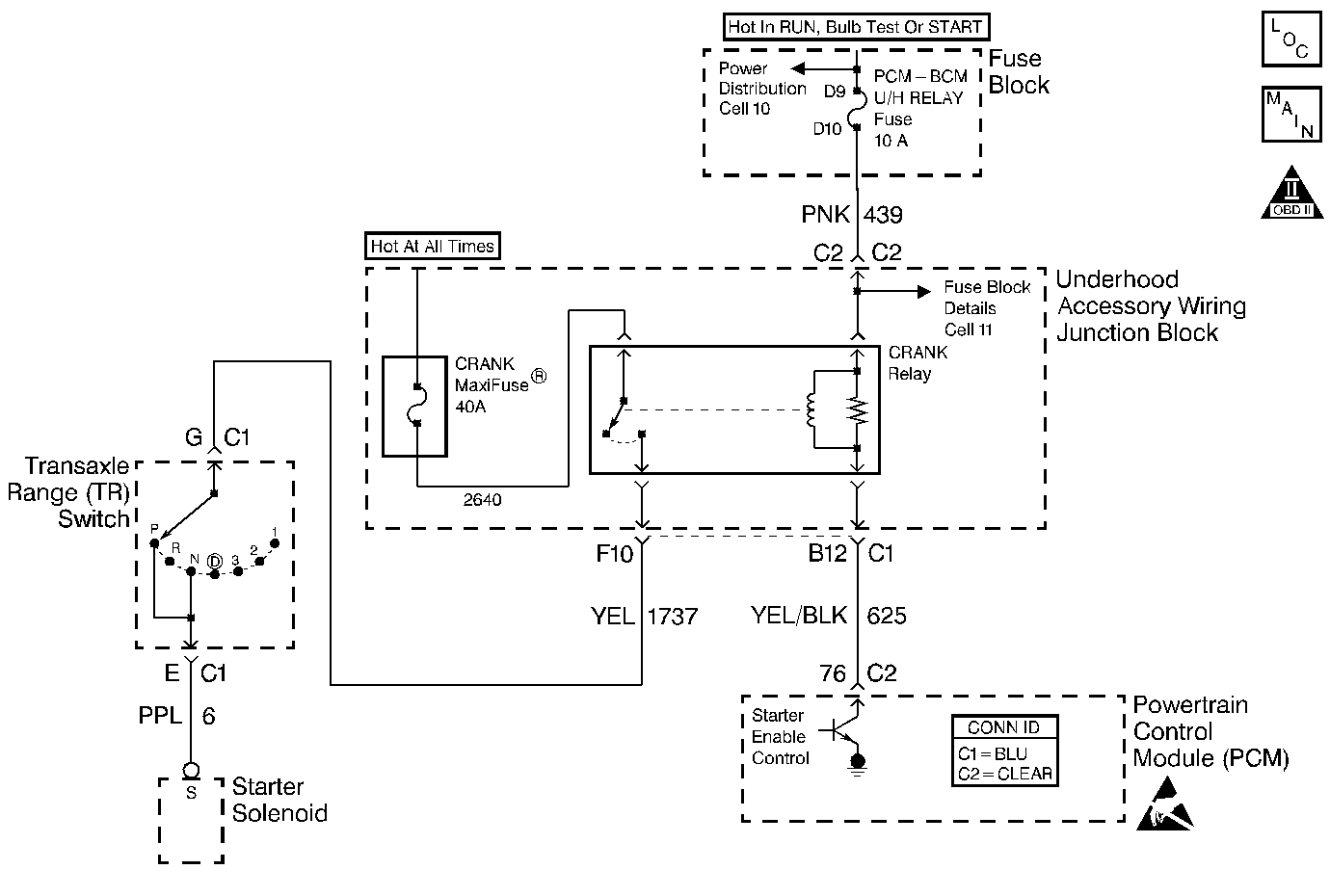
Circuit Description
The PCM has the ability to disable starter operation if conditions inappropriate for starter operation exist. The PCM disables the starter if the engine is running, if a correct VTD password is not received from the VTD system or if the vehicle operator attempts to engage the starter for an extended period of time.
The PCM controlled starter system consists of the following components:
| • | Starter enable relay. |
| • | The Transaxle Range / Park Neutral Position switch. |
| • | The ignition switch. |
| • | The starter solenoid. |
| • | The PCM. |
Diagnostic Aids
The PCM Controlled Starter Diagnosis table is intended to identify electrical malfunctions that can occur with the system. For additional system diagnosis, refer to Starter and Charging. For starter motor diagnosis and on-vehicle service, refer to Cranking System .
Check for the following conditions:
| • | Poor connection at the PCM , the starter enable relay, the Transaxle Range / PNP switch, the ignition switch or the starter solenoid. |
| Inspect harness connectors for the following conditions: |
| - | Backed out terminals. |
| - | Improper mating. |
| - | Broken locks. |
| - | Improperly formed or damaged terminals. |
| - | Poor terminal to wire connection. |
| • | Damaged harness. |
| Inspect the wiring harness for damage. |
| • | VIN 1 - Either of the following conditions can cause the PCM to disable starter operation: |
| - | The engine is running. |
| - | The starter has been continuously engaged for longer than 30 seconds. |
| - | A correct VTD password has not been received from the VTD system. |
| • | VIN K - Either of the following conditions can cause the PCM to disable starter operation: |
| - | The engine is running. |
| - | The starter has been continuously engaged for longer than 15 seconds. |
| - | A correct VTD password has not been received from the VTD system. |
Step | Action | Value(s) | Yes | No | ||||||
|---|---|---|---|---|---|---|---|---|---|---|
1 | Was the Powertrain On-Board Diagnostic (OBD) System Check performed? | -- | Go to Step 2 | |||||||
2 |
Important: If any DTCs are set, diagnose the other DTCs first. Attempt to start the engine. Does the engine start? | -- | Go to Diagnostic Aids | |||||||
3 | Check the Maxifuse® whcih feeds the starter solenoid. Refer to Fuse Block Schematics in Wiring Systems. Is the Maxifuse® Blown? | -- | ||||||||
4 |
Is the test lamp ON? | -- | ||||||||
5 |
Is the test lamp ON? | -- | ||||||||
6 |
Was a problem found? | -- | ||||||||
7 |
Is the test lamp ON? | -- | ||||||||
8 |
Important: When performing this step, the engine may crank. Ensure that the following
conditions are met:
Does the engine crank? | -- | ||||||||
9 |
Does the engine crank? | -- | ||||||||
10 |
Was a problem found? | -- | ||||||||
11 |
Was a problem found? | -- | ||||||||
12 |
Is the fuse blown? | -- | ||||||||
13 |
Is the test lamp ON? | -- | ||||||||
14 |
Is the current draw within the specified values? | 0.5 - 1.5 amps | ||||||||
15 |
Is the test lamp ON? | -- | ||||||||
16 |
Does the DMM indicate a voltage near the specified value? | B+ | ||||||||
17 |
Was a problem found? | -- | ||||||||
18 |
Was a problem found.? | -- | ||||||||
19 | Locate and repair the short to ground in the battery positive feed circuit to the starter relay. Refer to Wiring Repairs in Wiring Systems. Is action complete? | -- | -- | |||||||
20 |
Is action complete? | -- | -- | |||||||
21 | Locate and repair the open in the battery positive feed circuit to the starter relay. Refer to Wiring Repairs in Wiring Systems. Is action complete? | -- | -- | |||||||
22 |
Is action complete? | -- | -- | |||||||
23 | Locate and repair the open in the ignition positive feed circuit (CKT 439) to the starter relay. Refer to Wiring Repairs in Wiring Systems. Is action complete? | -- | -- | |||||||
24 | Replace the Starter Solenoid. Is action complete? | -- | -- | |||||||
25 | Replace the Trans Range Switch. Refer to Park/Neutral Position Switch Replacement in Automatic Transaxle-4T60-E or Park/Neutral Position Switch Replacement in Automatic Transaxle-4T65-E. Is action complete? | -- | -- | |||||||
26 | Replace the ignition system relay. Is action complete? | -- | -- | |||||||
27 | Replace the starter relay. Is action complete? | -- | -- | |||||||
28 |
Important: The replacement PCM must be programmed. Refer to Powertrain Control Module Replacement/Programming . Replace the PCM. Is action complete? | -- | -- | |||||||
29 | Attempt to start the vehicle. Does the engine crank? | -- | System OK |
